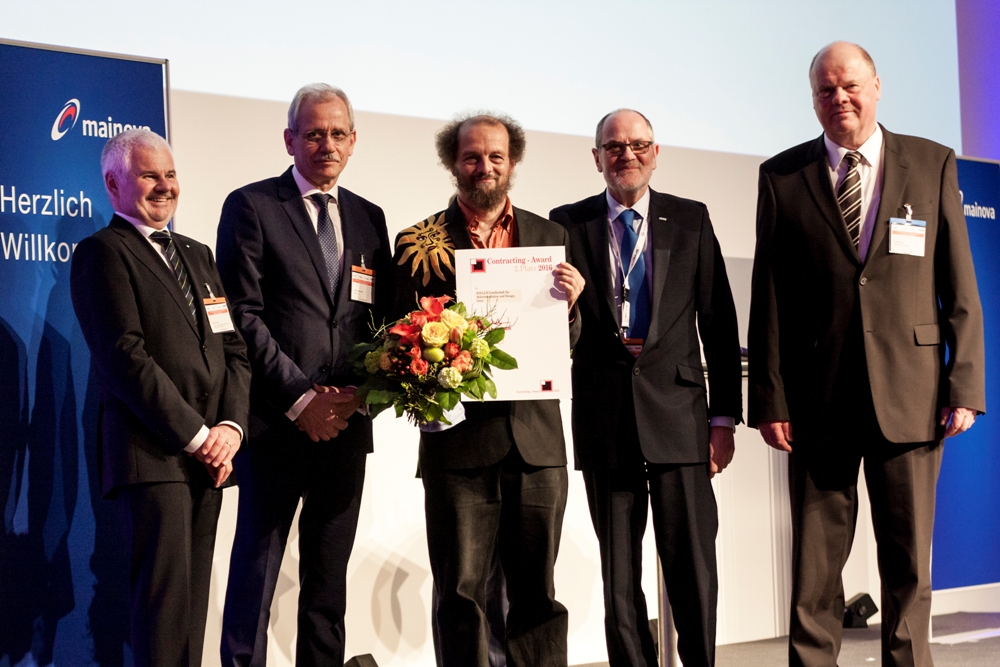News
Posted: May 26, 2016

Energy Service Companies (ESCO) have become pioneers in the development of financing and operating models for various energy sector customers. Every two years, the so-called Contracting Award highlights exemplary ESCO projects in Germany (“Contracting” is the German word for Energy Service Contracts). For the first time since the launch of the awards in 1997, the jury members from the magazine Energy & Management and the German Heat & Power Association, AGFW, presented one of these awards to a solar thermal ESCO. On 16 April, Christian Holter (third from left), Managing Director of Austrian turnkey system supplier S.O.L.I.D., was presented with the second prize for its solar energy supply contract with a district heating company in the Austrian city of Graz. The company published Tech Sheets and Fact Sheets about ESCO models as part of the IEA’s Solar Heating and Cooling programme’s Task 45, Large Scale Solar Heating and Cooling Systems.
According to a May 2015 survey, S.O.L.I.D. was the second largest solar thermal ESCO in terms of collector area under contract (13 solar heating and cooling systems totalling 26,427 m2). The largest one was Pampa Elvira Solar in Chile, which has been operating a 39,300 m2 solar process heat installation at a copper mine since October 2013.
|
Company, Country
|
Collector area operated by ESCOs
|
No. of systems
|
Comments
|
|
Pampa Elvira Solar, Chile
|
39,300 m2
|
1
|
Largest solar process heat installation worldwide; link
|
|
S.O.L.I.D., Austria
|
26,427 m2
|
13
|
Solar heating and cooling installations in Austria, Singapore and the USA
|
|
Nextility (formerly Skyline Innovations), USA
|
17,100 m2
|
210
|
Solar water heater systems for multi-family buildings in the USA; link
|
|
Wien Energie (formerly Energiecomfort), Austria
|
5,000 m2
|
50
|
Multi-family buildings in Austria
|
|
EDF Optimal Solutions, France
|
1,500 m2
|
1
|
Solar process heat for dairy producer in France
|
|
Aspiration Energy, India
|
1,365 m2
|
1
|
Solar process heat for wheel producer in India
|
|
Sumersol, Spain
|
750 m2
|
8
|
Six retirement homes, one hotel and one industrial laundry in Spain
|
|
Enertracting, Germany
|
585 m2
|
2
|
Gas pressure regulators and two multi-family buildings in Germany
|
Largest solar heating and cooling ESCOs worldwide in terms of their collector area in operation
Source: solrico research published in April 2015
The table above shows that ESCO models are used for all kinds of commercial and industrial customers from tourism, manufacturing and construction. Projects range from 80 m2 of collector area to almost 40,000 m2. The advantages for customers of ESCO models are evident and listed in the Task 45 Tech Sheet paper written by Sabine Putz, COO and Head of R&D at S.O.L.I.D.:
- No or very low investment for customers
- Minimised financial risk
- Turnkey energy service package (no involvement of the customer in technical issues, such as operation or maintenance)
- Guaranteed solar energy prices (advantage over other energy sources)
- Prestige (standing out from one’s competitors, showing openness to new technologies).
The main ESCO model is described as Energy Performance Contracting (EPC) in the Energy Service Directive (2006/32/EC):
EPC is a form of creative financing for capital improvement which allows funding energy upgrades from cost reductions. Under an EPC arrangement an external organisation (ESCO) implements a project to deliver energy efficiency, or a renewable energy project, and uses the stream of income from the cost savings, or the renewable energy produced, to repay the costs of the project, including the costs of the investment. Essentially the ESCO will not receive its payment unless the project delivers energy savings as expected.
The ESCO is the central component of the business model, dealing with the turnkey system supplier, attracting financing, and operating and maintaining the system (see the following diagram). The customer is the one signing the Energy Service Contract with the ESCO.

The basics of Energy Performance Contracting (EPC)
Source: S.O.L.I.D.
The Tech Sheet describes two variations of the EPC model: If capital is provided by third-party financing, the client will also have to pay a deposit directly to the outside investor. The other frequently used type of ESCO model is Heat Delivery Contracting (HDC), which means that the ESCO takes over complete responsibility for providing the client with an agreed-upon range of energy services (e.g., space heat, lighting, etc.) including primary energy purchase. It is an extreme form of energy management outsourcing.
Putz said that although the Energy Service Directive mandated Member States to remove market barriers and stimulate the energy service market by May 2008, there was still a lack of implementation in several countries. Part of the Tech Sheet is an overview of ESCO market barriers in EU Member States based on research carried out in 2011 in the framework of EU project BioSolESCO. These research efforts were focused on analysing barriers of biomass and solar thermal ESCO projects.
Websites of companies mentioned in the article: